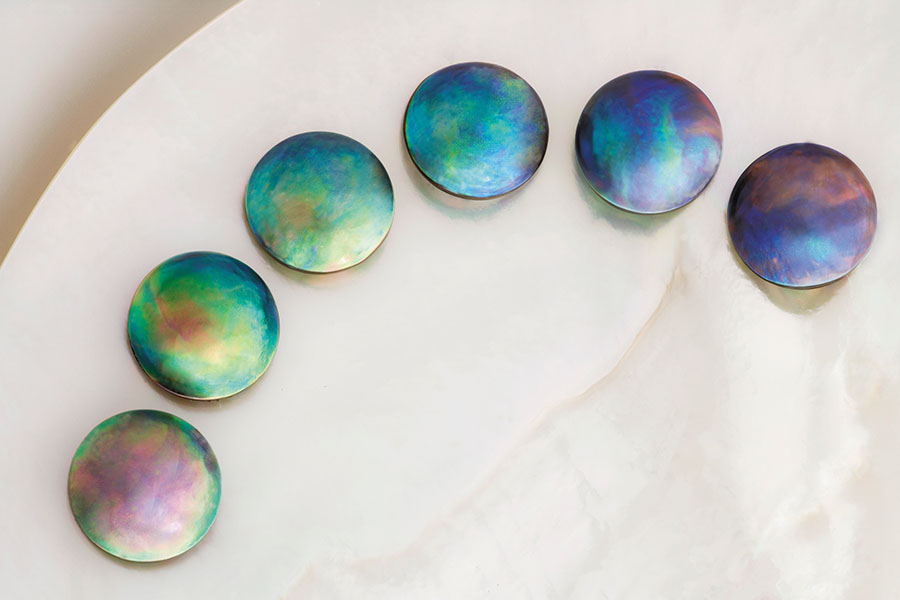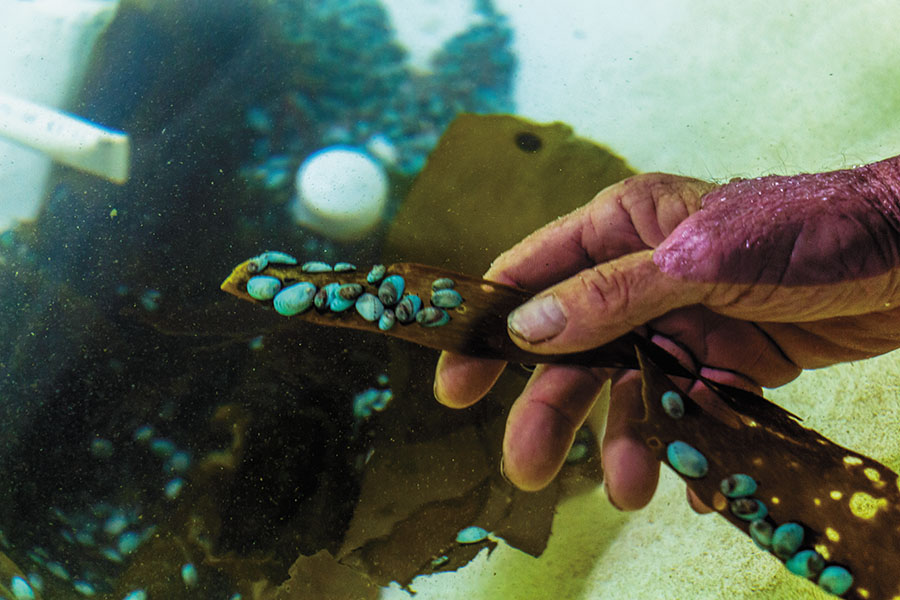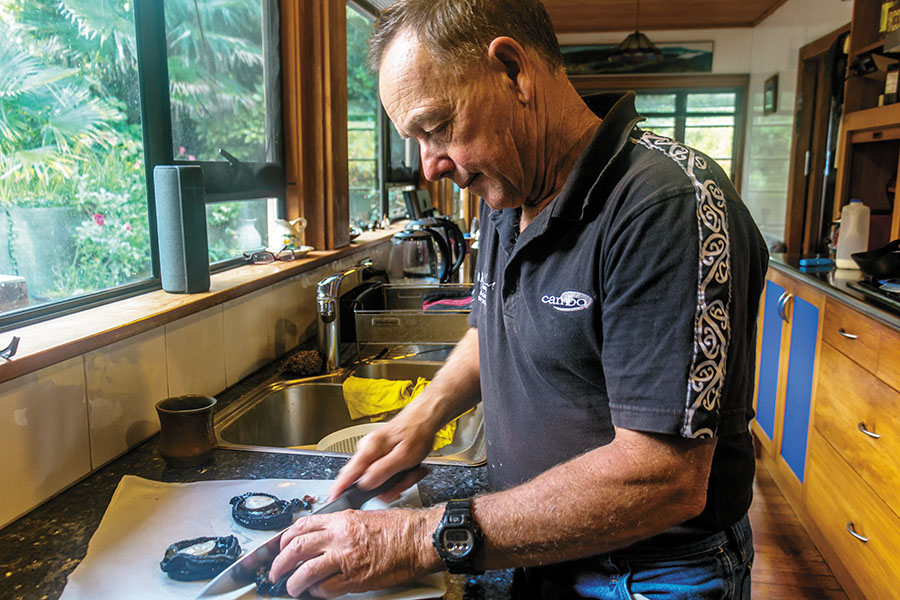
New Zealand's paua: Growing a rainbow
Farming the pearl is a work of patience and skill

The colours in the paua pearl aren’t found in any other pearl
I watch Mike Radon in action. He holds the shell in one hand, and a gentle push with a blunt tool is enough for the mollusc to be pried from the shell. It is fascinating to watch the gastropod called abalone—or ‘paua’ as the indigenous Maori tribe of New Zealand call it—move outside its shell.
Unlike oysters, which are bivalves (with two shells hinged at the centre), the paua are single-shelled univalve saltwater mollusc. As they glide along sea tides, they latch on to rocks with their muscular foot. A Maori’s strength is often compared to the tenacious grip of a paua. Belonging to the Haliotidae family, three species of paua are commonly found in New Zealand—Haliotis iris, Haliotis australis and Haliotis virginea. Unlike the abalone found across the world, the New Zealand Iris (iris is rainbow in Latin) endemic to the cold waters of the country stands apart, and is distinguished by a riot of colours in its shells. The opalescent colours in the mother-of-pearl of the paua caused due to the refraction of light through its layers of calcium carbonate aren’t found in any other mollusc.
I am at Radon’s Arapawa Homestead, a farm in the picturesque Marlborough Sounds at the northern end of the South Island of New Zealand. The Sounds are nature’s creation during the last ice age about 10,000 years ago, when rising sea levels drowned the valleys in the region. The expanse is a delight to soak in, with numerous coves, bays and islands.
Radon, 68, an American, set up the 700-acre farm at Tory Channel with his Kiwi wife Antonia in 1993, and became a paua farmer in 1998; today, he is one of only a handful of farmers involved in paua pearl culture in New Zealand. Inside their closed paua farm shed, tubs of paua are stacked on racks, with a bucket above every tub. Water pumped from the sea is poured into the tub automatically from the bucket every 10 minutes, thus replenishing the water and imitating a marine environment for the paua.
Radon tells me, “I started diving in California at the age of 13. The abalone there were bigger than the ones you find in New Zealand. Here, at Arapawa, we harvest from the sea only the iris, or the black-footed paua that is unique to New Zealand. We also have our own hatchery where we spawn and fertilise them artificially.”


Mike Radon shows a few baby paua in his nursery
He gives me a rundown on paua hatching. Hydrogen peroxide added to a bucket of sea water where the paua super oxygenates the water and induces an environment like a storm. After three hours, the water is changed, and the room is darkened, thus creating a calm setting after the storm. The male and female gonads then release sperms and eggs through the apertures in the shell after which they are artificially fertilised. The fertilised eggs hatch to release microscopic larvae, which are kept in larval tanks for 10 days. Later they are kept in separate tanks for eight months, after which they are raised in the regular tanks for the next five years.
Artificially fertilising and growing paua might seem like a lot of work. But harvesting it from its wild environment is not easy either. The ministry of fisheries does not allow paua divers to carry underwater breathing apparatus—in order to allow the stocks of paua in deeper waters to get replenished. Also, they are allowed a limited catch quota to avoid over fishing. To ensure sustainability and avoid over-exploitation of its marine resources, the ministry introduced the Quota Management System, under which the catch quota varies for each of the 11 fishery management areas spread along the coast, based on its population and health.
Radon’s catch quota is about 2 tonnes for a year. “We use a snorkel and dive to depths ranging from five to 20 feet. The bag gets heavy as three paua with their shells weigh a kilogramme. It’s like a marathon, but while holding your breath. We are huffing and puffing as we get out of the water.” Government regulations also have stringent rules regarding the size of the paua harvested. It shouldn’t be less than 125 mm across the greatest oval length of its shell, which is the size of an adult paua. This restriction ensures conservation of the paua population. The harvested paua are either sold for meat or raised in the tanks at paua farms.
Roger Beattie, 63, who has been living for 26 years in Christchurch on the east coast of New Zealand’s South Island, owns 5 hectares of marine farm, and is the owner of the Eyris Blue Pearl Company. His method of paua cultivation is different from Radon’s. Beattie says his paua are cultured in huge, 200-litre drums. Slightly tapered, the drums are compartmentalised by dividers, and have a removable lid, and a bottom and sides made of mesh and panels. They are suspended underwater, clipped to a backbone. The paua latch on to the dividers and sides of the drum, while feeding on sea weed. The drums are cleaned every second week. “When farmed in the ocean, the pearls get a much better colour,” he states.
The Iris paua pearl in New Zealand comes in four colours: Blue violet, blue green, green blue and green gold-pink
The paua pearl, or the blue pearl, has the colours of the rainbow; no other variety of pearl has the paua’s wide spectrum of colours. “It has the greatest range of colours of any pearl, and also within each pearl,” says Beattie. The paua pearl has four main colours—blue violet, blue green, green blue, and green gold-pink. Depending on the angle from which you look, the colours change. “It’s a chameleon, and they play with the human eye as the colours dance,” he says.
Experiments on abalone pearl culture have been carried out since the early 20th century, the pioneer being French scientist Louis Boutan. Today, the paua are nucleated by introducing a small dome-shaped object between the mantle and the shell. This process must be done with utmost care, since even a tiny cut is enough for a paua to bleed to death because they are haemophiliac (their blood does not contain a clotting agent).
The paua do not take foreign bodies easily and eject them. So, the nucleus is inserted in an area from which it is difficult to expel. Antonia says, “Three or four beads are nucleated in one paua—around the gut, to the side, and near the mouth.” Once nucleated, the paua must be cultured in a stress-free environment over three years so that nacre—the inner lining of the shell—builds over the foreign object to produce the lustrous paua pearl. The temperature and composition of the water, its flow and the sea weed that the paua feed on affects the wide spectrum of the blue pearl colours, which determines its quality.

Mike Radon chops freshly shucked paua to fry them in butter in Arapawa, New Zealand
“The biggest challenge in paua pearls is to find matching pearls for earrings,” exclaims Beattie. It is difficult to get a pearl of the same colours, because every blue pearl is unique. “But one doesn’t look at both the ears at the same time,” he reasons. “Wholesale price ranges from NZD 100 to NZD 20,000 for a single paua pearl. The average selling price is NZD 300. After you set it in jewellery, the cost increases three to five times.” These blue pearls are unique to New Zealand. “Former prime minister of New Zealand John Key gifted a brooch, set with a paua pearl from Eyris Blue Pearl Company, to the Queen of England during his visit in 2013,” he claims, proudly.
Every part of the paua is used: Pearl, meat and its shell. After harvesting the blue pearl, the Radons feed the guts to the eels, and sell the meat as a frozen product. The meat—a delicacy in Maori cuisine—plays a major role while hosting visitors of high rank. Once the blister pearl is cut from the opalescent shell, the rest of the shell is used for making trinkets and adornments. A few days ago, at Te Puia, home to Māori Arts and Crafts Institute in Rotorua, I had watched Maori carvers inlay the shells as eyes in wooden figures. Handcrafted paua jewellery is commonly found all over New Zealand.
At Arapawa Homestead, I admire the Radons’ collection of shells. Antonia has baked a delicious, soft and spongy cake. Radon chops the freshly shucked paua to fry them in butter with a dash of pepper and salt. But I am riveted by the pearls: A liquid swirl of colours from the blue sky, a dash of brilliance from the dawn, the hues of the sunset, and the vibrancy of forest merged together.
The writer travelled to New Zealand at the invitation of New Zealand Tourism
(This story appears in the 09 November, 2018 issue of Forbes India. To visit our Archives, click here.)
Post Your Comment














